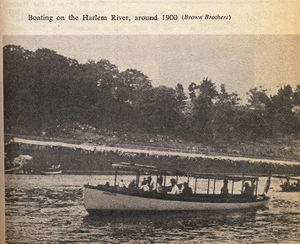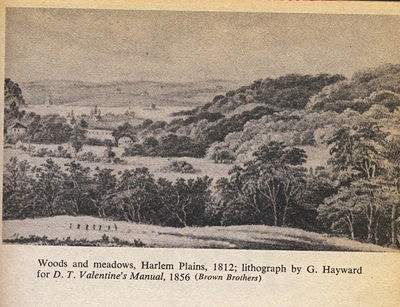| wiki | search |
Main Page | Groups and Assignments | Bios | History | Harlem | Diversity Today | Help
Harlem had initially been a prosperous rural and isolated village which became worthless after it stopped being fertile due to centuries of use. This caused people to sell large and magnificent estates for paltry sums and sometimes even abandon the land by mid 1800s. Despite the fact that Harlem was no longer useful as farmland, it continued to retain its picturesque rural beauty. Many older and well-off residents moved to Harlem to escape the crowding of downtown Manhattan and experience the beauty of Harlem. Harlem was annexed into New York City in 1873 and from 1878-1881 the railroad started reaching 129th street and by 1886 it traveled even further allowing more people access to the area. Harlem became an area that held a portion of New York City’s population that was relatively well-off. While the area had a wealthy white population, it also held a small black population since a few blacks had stayed from the time of slavery. New blacks moved in with the whites as domestic servants. The black population and the Italian population grew in the area. Real estate boom and speculation were rampant in the area due to the belief that property values would increase dramatically when the subway line to Harlem was completed, thus people were buying property at exorbitant sums and creating large apartment complexes in hopes of renting them since rents in Harlem had been thought to be worth almost 4 times as much as the rents paid by an average family in the city.
The real estate bubble burst in 1904-1905 when people realized that no one was sure when the subway line would be completed and that too many apartment buildings had been created and there was not enough demand and even if there was demand the rents were too high for most people to afford. Thus to avoid losing the investment some landlords allowed blacks to move into the neighborhoods and pay high rents as was the norm for black tenants in the city. The renting of houses to blacks led to wild panic in Harlem and owners starting selling their property at any price; however, few were willing to buy thus the property values depreciated even further. Some White landlords resisted renting their apartments to black tenants for a considerable while; however, eventually they became unable to sustain the economic losses and opened their property to black tenants. Wealthier blacks moved into the area since due to the Great Migration there was a tremendous increase in the black population of the city. Black churches played a key role in creating black Harlem since they bought the property at depreciated costs and helped many blacks settle there. After a large black population was settled in the area it was reasonable and relatively easy for newcomers to settle in the area and the Great Migration indubitably aided in the increase in Harlem’s black population.


